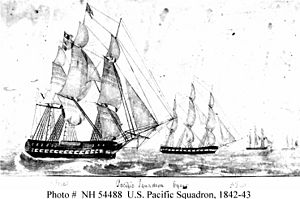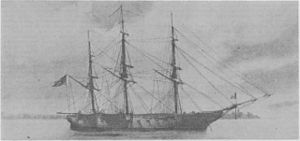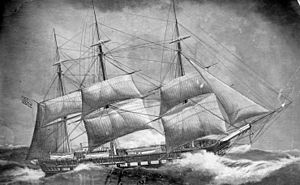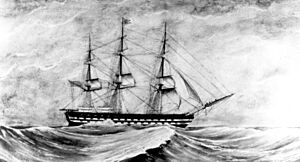Pacific Squadron facts for kids
Quick facts for kids Pacific Squadron |
|
|---|---|
 |
|
| Active | 1820-1910 |
| Country | |
| Branch | |
| Type | Naval squadron |
The Pacific Squadron was a group of United States Navy ships. They were stationed in the Pacific Ocean during the 1800s and early 1900s. At first, the U.S. had no ports on the Pacific coast. So, the squadron used special supply ships. They also bought food and water from ports in the Hawaiian Islands and other towns.
Throughout its history, the Pacific Squadron faced many challenges. More than half of the U.S. Navy joined this squadron during the Mexican–American War. During the American Civil War, many ships were sent to the Atlantic. After the Civil War, the squadron grew strong again. It was finally ended in the early 1900s.
History of the Pacific Squadron
How the Squadron Started
The "United States Naval Forces on Pacific Station" began in 1818. The USS Macedonian was the first ship. It sailed to protect American interests in the Pacific. This ship helped support the fight for Peru's independence.
Most historians agree the Pacific Squadron officially started in 1821. This was when more than one ship was sent to the Pacific. Charles Stewart arrived with the USS Franklin and USS Dolphin.
This small group of ships first worked near South America, North America, and Hawaii. They protected American trading ships. In 1835, their work expanded to the Western Pacific. This happened when the East India Squadron joined them. The squadron grew even larger when war with Mexico seemed possible. Sailing from the east coast to the west coast around Cape Horn was a very long trip. It was about 13,000 to 15,000 miles (21,000 to 24,000 km). This journey usually took 130 to 210 days.
Adventures in Sumatra
In February 1831, the Pacific Squadron faced a problem. An American merchant ship called Friendship was attacked. It was off the coast of Sumatra by local Malay people. Three American sailors were killed. The remaining crew left the ship, and it was taken.
Later, the surviving sailors got help from other American ships. They managed to get their ship back. When President Andrew Jackson heard about the attack, he was angry. He ordered Commodore John Downes to punish the attackers. Downes sailed with the USS Potomac.
A year later, Commodore Downes arrived off Sumatra. His sailors and marines attacked Quallah Battoo. This was the main village of the hostile Malays. The Americans went ashore in small boats. They sank three small pirate ships in the port. The USS Potomac also shelled five enemy forts. The forts were attacked by land and eventually taken. Many natives were killed, but only two Americans died. After the battle, Downes warned that more attacks would lead to more expeditions.
This mission was successful for six years. But in 1838, Malays attacked another American ship. So, a Second Sumatran Expedition was launched. Ships from the East India Squadron bombarded Quallah Battoo again.
Taking Control of Monterey
In 1842, the Pacific Squadron commander, Commodore Thomas ap Catesby Jones, got wrong information. He heard that war had started between the U.S. and Mexico. He also heard that a British ship was trying to take control of California.
So, Commodore Jones sailed to Monterey. He arrived on October 19, 1842. His ships were the USS United States, USS Dale, and USS Cyane. They took control of the city without fighting. But on October 21, Jones found out there was no war. He gave the city back to the Mexicans.
The Mexican–American War
California Campaign
The Pacific Squadron played a huge role in taking Alta California. This happened during the Mexican–American War (1846-1848). In the early days of the war, the American navy was the main U.S. military force in California. They had about 350-400 marines and sailors.
Marines were on each warship. They helped in close-up ship fights. They also served as guards and were the main part of landing parties. Sailors also joined the marines on land when needed. The Pacific Squadron had orders to capture Mexican ports in California if war broke out.
Another U.S. force in California was a small "mapping" group. It was led by U.S. Army Captain John C. Frémont. He had caused some trouble with the Mexican government. He also had a secret connection with American settlers. These settlers started the Bear Flag Revolt on June 10, 1846.
On July 7, 1846, Commodore John D. Sloat led the squadron. His ships, USS Savannah, Cyane, and USS Levant, captured Monterey, California. Two days later, USS Portsmouth captured Yerba Buena (now San Francisco). They did this without firing a shot. British ships watched but did not get involved in the fighting.
Commodore Robert F. Stockton took over as the main U.S. military commander in California. His main ship was the USS Congress. Stockton used Frémont's California Battalion to help secure Southern California. The battalion was made up of volunteers. They were paid like regular U.S. Army soldiers.
Pacific Squadron warships and supply ships helped Frémont's group. They provided supplies like gunpowder and lead. They also transported the soldiers to different California ports. The Cyane took Frémont and about 160 of his men to San Diego. San Diego was captured on July 29, 1846, without a fight.
Frémont then went to Los Angeles. On August 13, Stockton and Frémont's forces entered the town. No one was killed. Major Archibald Gillespie was put in charge of Los Angeles. But he had too few troops to keep order.
A revolt by about 100 Californios (Mexicans living in California) forced Gillespie to leave Los Angeles. Commodore Stockton used about 360 marines and sailors from the Congress. They worked with U.S. Army General Stephen W. Kearny and Frémont's men. They retook Los Angeles on January 10, 1847. This led to the Treaty of Cahuenga on January 13, 1847. This treaty ended the fighting in Alta California.
The USS Independence was brought back into service. It was rebuilt into a faster, lighter frigate. It became the flagship for Commodore William Shubrick. He was the new commander of the Pacific Squadron.
The 1st Regiment of New York Volunteers also came to California. These soldiers took over many of the Pacific Squadron's land duties. They also took over duties from other volunteer groups.
Pacific Coast Campaign
After Alta California was secured, most of the squadron moved south. They captured major cities on the Baja California peninsula. They also captured or destroyed almost all Mexican ships in the Gulf of California. Other ports on the mainland were also taken. The goal was to take Mazatlan, a big supply base for Mexico.
The Cyane alone captured eighteen ships and destroyed many others. The Independence, Congress, and Cyane seized La Paz. They also captured or burned the small Mexican fleet at Guaymas. Within a month, they cleared the Gulf of enemy ships. Later, their sailors and marines captured Mazatlan, Mexico, on November 11, 1847.
Mexico tried to retake the captured ports. This led to several small battles and sieges. The Pacific Squadron ships provided support during these fights. The Cyane returned home in October 1848. It was praised for its important role in American victories. The Treaty of Guadalupe Hidalgo officially ended the war in February 1848.
American Civil War Impact
In the 1850s, California and Oregon became U.S. states. Navy bases were built on the west coast. The Pacific Squadron's area of responsibility grew. During the American Civil War, the Pacific Squadron was far from the main fighting. Some of its ships were sent to the Atlantic. They fought in battles like the Battle of Forts Jackson and St. Philip.
Fighting Pirates
In July 1870, a pirate ship called Forward attacked Guaymas, Mexico. The pirates robbed foreign residents. They also forced the U.S. Consulate to give them coal. Then, they sailed south.
The Pacific Squadron was told about the attack. So, the USS Mohican was sent to destroy the pirates. In early August, the Mohican found Forward in the Teacapan River. On August 17, 1870, a group of American sailors attacked the pirate ship. The battle ended with an American victory. The pirate steamer was burned and sunk.
The Oahu Expedition
An American expedition went to Oahu in late 1873. The Pacific Squadron ships USS Tuscarora and USS Portsmouth were involved. They wanted to talk with King Lunalilo about sugar trade. They hoped to make sugar exports from Hawaii to America duty-free.
But King Lunalilo died on February 3, 1874. This stopped the talks. When a new king was chosen, Kalakaua won. The king's wife, Queen Emma, was very upset. She led an angry crowd in an attack on the courthouse in Honolulu.
As a result, 150 American sailors and marines landed from the ships. About 70-80 British sailors also landed. The riot was mostly stopped by nightfall. The American forces stayed until February 20. By then, the sugar talks were finished. The new king also allowed Americans to build a repair and coaling station in Pearl Harbor.
The Second Samoan Civil War
In 1899, another civil war broke out in Samoa. It was between rebels and government forces. Pacific Squadron Rear Admiral Albert Kautz arrived in the USS Philadelphia. He led an expedition to the island. They occupied the capital, Apia, on March 14, 1899. This happened after a battle and bombardment.
American, British, and Samoan forces fought several battles against the rebels. When the conflict ended, the United States gained control of eastern Samoa. This area is known today as American Samoa. The western half of the islands was taken by Germany.
The Squadron Ends
In 1903, the Pacific Squadron included ships like the USS New York and the USS Boston.
In early 1907, the U.S. Navy made a big change. They ended both the Pacific Squadron and the United States Asiatic Fleet. In their place, they created the new United States Pacific Fleet. The ships and people from the old squadrons became parts of this new, larger fleet.
Leaders of the Pacific Squadron
Pacific Squadron
- Captain John Downes 1818–1820
- Captain Charles Goodwin Ridgely 1820–1821
- Commodore Charles Stewart 1821–1823
- Commodore Isaac Hull 1823–1827
- Commodore Jacob Jones 1826–1829
- Commodore Charles C. B. Thompson 1829–1831
- Commodore John Downes 1832–1834
- Commodore Alexander Scammel Wadsworth 1834–1836
- Commodore Henry E. Ballard 1837–1839
- Commodore Alexander Claxton 1839–1841
- Commodore Thomas ap Catesby Jones 1842–1843
- Commodore Alexander J. Dallas 1843–1844
- Captain James Armstrong 1844
- Commodore John Drake Sloat 1844–1846
- Commodore Robert Field Stockton 1846
- Commodore James Biddle March 2 – July 19, 1847
- Commodore W. Branford Shubrick 1847–1848
- Commodore Thomas ap Catesby Jones 1848–1850
- Commodore Charles S. McCauley 1850–1853
- Commodore Bladen Dulany 1853–1855
- Commodore William Mervine September 1855–October 1857
- Commodore John C. Long 1857–1859
- Commodore John B. Montgomery 1859 – January 2, 1862
- Acting Rear Admiral Charles H. Bell January 2, 1862 – October 25, 1864
- Rear Admiral George F. Pearson, October 4, 1864 – 1866
North Pacific Squadron 1866–1869
- Rear Admiral Henry K. Thatcher 1866–1868
- Rear Admiral Thomas T. Craven 1868–1869
South Pacific Squadron 1866–1869
- Rear Admiral George F. Pearson, October 25, 1866 – 1867
- Rear Admiral John A. B. Dahlgren 1867–1869
- Rear Admiral Thomas Turner 1869–1870
Pacific Station 1872–1878
- Rear Admiral Thomas Turner 1869–1870
- Rear Admiral John Ancrum Winslow 1870–1872
- Rear Admiral John J. Almy September 1873 – July 1876
Pacific Squadron 1878–1907
- Rear Admiral Christopher Raymond Perry Rodgers 1878–1880
- Rear Admiral Thomas H. Stevens 1880–1881
- Rear Admiral Lewis Kimberly 1887–1890
- Commodore Joseph S. Skerrett 1892–1893
- Rear Admiral John Irwin 1893–1894
- Rear Admiral Lester A. Beardslee 1894–1897
- Rear Admiral J. N. Miller July 27, 1898
- Rear Admiral Albert Kautz 1898-1901
- Rear Admiral Silas Casey III 1901 – 1903
- Rear Admiral Henry Glass 1903 – March 1905
- Rear Admiral Caspar Frederick Goodrich 1905–1906
- Rear Admiral William T. Swinburne 1906–1907
Ships of the Squadron
Here are some of the ships that served in the Pacific Squadron:
1845–1849
- Independence, frigate (razee); 54 guns, ~500 crew
- Congress, frigate; 44 guns, 480 crew
- Savannah, frigate; 44 guns, 480 crew
- Columbus, ship of the line; 74 guns, 780 crew
- Portsmouth, sloop; 20 guns, 200 crew
- Cyane, sloop; 20 guns, 200 crew
- Levant, sloop; 20 guns, 200 crew
- Preble, sloop; 16 guns, 150 crew - Stevenson's convoy escort
- Dale, sloop, 16 guns, 150 crew
- Erie, storeship (bark); 4 guns, unknown crew
- Relief, storeship; 408 tons, 6 guns, unknown crew
- Warren, storeship (sloop); 691 tons, 18 guns, unknown crew
- Brutus, storeship - for Stevenson's regiment, chartered?
- Libertad, Schooner; unknown guns, ~20 crew
- plus other ships captured during the war against Mexico
1851
- Savannah, frigate; 44 guns, 480 crew
- Raritan, frigate; 44 guns, 480 crew
- Falmouth, sloop; 20 guns, 200 crew
- St. Mary's, sloop; 20 guns, 200 crew
- Vandalia, sloop; 20 guns, 200 crew
- Vincennes, sloop; 20 guns, 200 crew
- Warren, storeship (sloop); 20 guns, 200 crew
- Lexington, storeship
- Southampton, storeship
- Supply, storeship
- Massachusetts, steamer
1861-1865
1861
- Lancaster, screw sloop-of-war, 24 × 9 inch smoothbore Dahlgren guns, 1 × 2 inch smoothbore Dahlgren gun, 2 × 30-pounder Parrott rifles, 367 men
- Saranac, side wheel steam sloop-of-war, 9 × 8-inch guns, complement unknown
- Wyoming, screw sloop-of-war, 2 × 11 inch smoothbore Dahlgren guns, 1 × 60-pounder Parrott rifle, 3 × 32-pounder guns, 198 men
- Narragansett, 2nd class screw sloop-of-war, 1 × 11 inch gun, 4 × 32-pounder guns, 50 men
- St. Mary's, sloop of war, 16 × 32-pounder guns, 6 × 8 inch guns, 195 men
- Cyane, sloop 20 guns, 200 crew
- Camanche, Passaic-class monitor, 2 × 15 inch smoothbore cannons, 76 men
- Shubrick, lighthouse tender steamer







